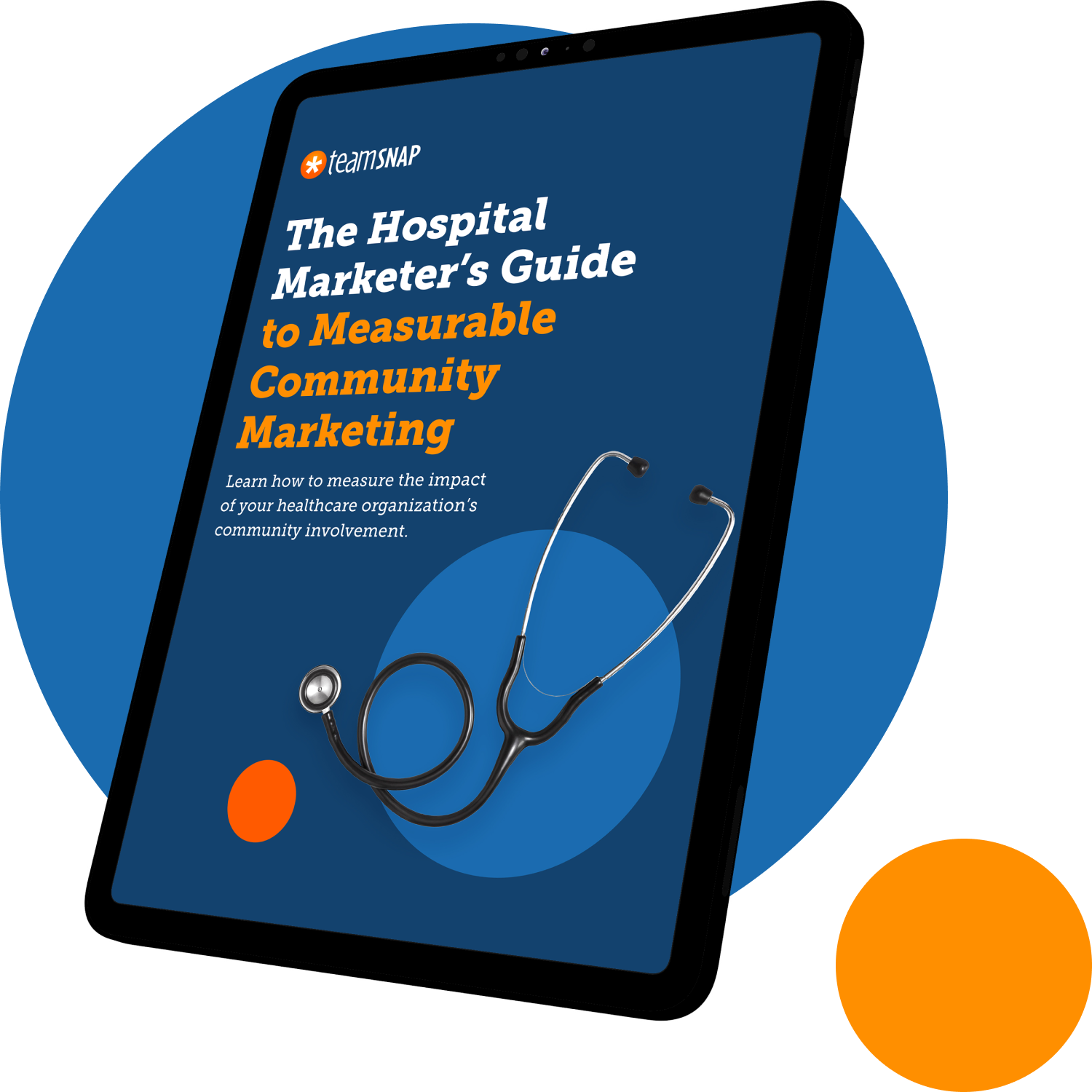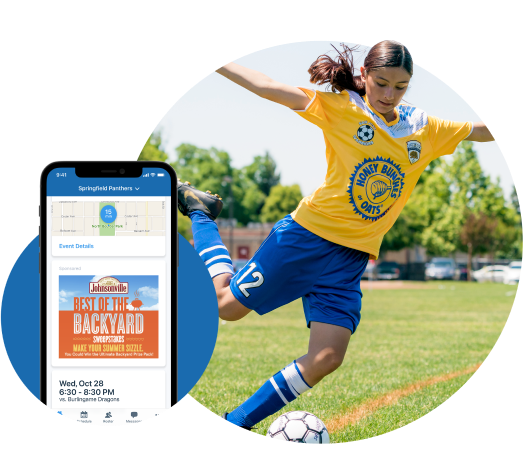Healthcare Advertising With Local Sponsorships
Learn how to connect your healthcare organization with families in the community with measurable local marketing.
Download the Guide

Healthcare Advertising With Sports Sponsorships
TeamSnap empowers brands to create authentic relationships with families through youth sports sponsorships and digital media targeting families in the #1 youth sports coordination app. Unlike other marketing channels, we engage families when and where it matters most - at the field, at home, and on the go.
Learn how our partners including Dairy Queen, Gatorade, Johnsonville, Marriott, and Panda Express use TeamSnap to reach the Chief Household Officer.
Learn MoreHEALTHCARE ADVERTISING
Of all the types of advertising, healthcare advertising can be one of the most challenging. While healthcare marketers use many of the same tools as marketers for other industries, they must abide by privacy regulations for the health industry. They also must understand the complexities of various medical conditions, the needs of various patients, and the different types of insurance.
Yet, there are many benefits of marketing in healthcare. Besides the reward of connecting patients with physicians and medical facilities for care and treatment, marketing professionals can accomplish the following benefits on behalf of their clients and teams.
- Increase awareness of services. Healthcare marketing can be effective in informing the public of various medical conditions and the preventative measures and treatments to manage them. It also can be instrumental in helping them feel confident about making informed decisions about their health.
- Help medical providers connect with more patients. With the healthcare industry becoming more competitive, healthcare marketing can be critical in helping a provider connect with more patients.
- Encourage patient loyalty. Through various types of healthcare marketing, including digital newsletters, print collateral, and social media, medical providers can ensure that they’re regularly communicating with their patients and, consequently, build patient engagement and patient loyalty.
HISTORY OF HEALTHCARE MARKETING
Although the concept of marketing dates to ancient times, it wasn’t until the early 1900’s that the marketing form of marketing, with a mix of strategies and approaches, took hold. However, healthcare marketing emerged much later.
Early adopters of healthcare marketing included healthcare organizations, including hospitals, and some healthcare suppliers and retailers. In many cases, hospitals limited their marketing to public relations to ensure that their audiences were informed about new developments at their institutions, such as expansions, new staff, or health fairs,
It wasn’t until the 1980s, that physicians and other healthcare providers started exploring healthcare marketing as a strategy to attract more patients. Many people in the healthcare industry have attributed the emergence of healthcare marketing to pioneers, such as Scott MacStravic, who published the book Marketing Health Care in 1977, and Eric Berkowitz, a marketing professor at the University of Massachusetts.
By the late 1980s, many healthcare organizations had embraced marketing as part of their organizational structure. In the following decades, hospitals and other medical providers started hiring marketing executives and teams to build out full marketing departments.
WHAT IS HEALTHCARE MARKETING
What is healthcare marketing at its core? A widely accepted healthcare marketing definition is that it is a process that combines various forms of traditional and digital tools, tactics, and outreach strategies. The end goal is to attract consumers seeking healthcare. This process includes developing a strategy for guiding them through the various stages of their healthcare journey.
As outlined in leading healthcare marketing articles, healthcare marketing continues to evolve to include advanced digital healthcare marketing strategies and tools. However, while many marketers in numerous industries can use the latest marketing technology solutions, they must be mindful of the answer to the question, “How is healthcare marketing different from marketing in other industries?”
While laws governing international healthcare marketing vary, healthcare marketers in the United States must make sure marketing solutions are HIPPA (Health Insurance Portability and Accountability Act) compliant. This federal law, which was enacted in 1996, provides national standards to protect sensitive patient health from being disclosed without the patient’s consent or knowledge. For that reason, companies promote industry-specific marketing tools that are HIPAA-compliant.
With most marketing strategies demanding a highly personalized experience, healthcare marketing professionals must constantly be mindful of navigating HIPAA regulations when striving to create campaigns that resonate with targeted audiences.
Healthcare marketing also includes a focus on educating patients about the services available to them, preventative measures for various conditions, and how to advocate for their health. For that reason, healthcare marketers must be careful to ensure that all information on websites, brochures, social media, and other platforms is accurate, trustworthy, and reliable.
HEALTHCARE MARKETING EXAMPLES
Despite numerous regulations, healthcare marketing campaigns can widely vary in creativity and approach. Healthcare advertising examples highlighted in recent healthcare marketing articles range from dramatic depictions of patients recovering from serious ailments to animated characters in funny healthcare ads.
Marketing agencies and professionals regularly demonstrate their range and creativity, as seen in the following healthcare marketing examples:
- Urging audiences to change behaviors. Many healthcare campaigns have centered around motivating their audiences to change behaviors that harm their health, including smoking, doing drugs, and excessively drinking alcohol. Many medical providers implemented similar tactics in the wake of the COVID-19 pandemic. For example, medical executives in Minnesota placed a full-page newspaper ad (https://mhealthfairview.org/-/media/3C977E375ADA4D3B9B8D7C6AF3C817B1.ashx) to urge people to get vaccinated. The ad was emotional in tone: “We’re heartbroken. We’re overwhelmed. Our emergency departments are overfilled, and we have patients in every bed in our hospitals. This pandemic has strained our operations and demoralized many people on our teams.” It was signed by nine executives of major healthcare systems.
- Educating audiences about a condition. As part of an animated ad, GlaxoSmithKline demonstrated a fun approach in one of the most positive health advertisement examples of 2021. The health marketing campaign (https://www.ispot.tv/ad/OxL6/glaxosmithkline-whooping-cough-pool-floaties) was designed to educate audiences that whooping cough is not just an ailment that affects children.
- Patient testimonials. Many medical facilities and providers have used digital healthcare marketing strategies successfully by highlighting their patients who have undergone procedures or treatment. These types of marketing campaigns can be effective in establishing trust.
5 PS OF HEALTHCARE MARKETING
As marketing research in healthcare has revealed more insights about the impact of different approaches, many more professionals have implemented the 5 Ps of marketing as a strategic approach for their healthcare marketing plans.
By consistently implementing these 5 Ps of healthcare marketing — Product, Place, Price, Promotion, and Personalization, marketers can effectively use a framework that stresses the importance of healthcare marketing for a hospital, medical facility, physician, or other medical practitioners.
The 5 Ps of an effective healthcare marketing plan include:
- Product: As with most industries, the quality of the product must be at the center of a healthcare marketing strategy. Medical providers must effectively communicate to prospective and current patients that the care that they will receive is exceptional. They must also build trust among their audiences — ensuring that they will be treated with respect and empathy.
- Place: Even with the emergence of telehealth, place or location continues to emerge as important in a healthcare marketing campaign. Patients must be assured that the services they seek are in a convenient location.
- Price: The importance of healthcare marketing strategies also can be demonstrated in how campaigns convey price. With healthcare, helping patients understand the options available to them, including the acceptance of various insurance plans and low-cost physician visits and common tests, is key.
- Promotion: Marketers also must use various types of promotional tactics to reach diverse populations. These can include digital marketing like social media, cable TV ads, printed brochures, in-person events, and newspaper ads.
- Personalization: Many medical providers reach audiences in a wide range of socioeconomic demographics, including age, income, and gender. Campaigns must consider how to effectively engage each of these types of audiences.
TYPES OF HEALTHCARE MARKETING
Technological advances in communication have led to the emergence of many different types of healthcare marketing approaches.
However, unlike other industries, a digital marketing strategy for healthcare must take into consideration regulations in the industry. This especially is the case for communications around healthcare social media campaigns, which tend to be more responsive and immediate than the development of a brochure, which could take weeks or months.
These differences must be addressed when posed with the question, “How is healthcare marketing different from marketing in other industries?” The following considerations are often highlighted among individuals holding healthcare marketing jobs within a hospital, medical facility, or physician’s office:
- Digital signage. Many medical facilities, including hospitals, are better able to control messaging through digital signage in waiting rooms. This allows them to promote their services, educational materials, and other relevant information to a captive audience that already is engaged with the facility. This type of marketing can boost patient loyalty.
- Website content. Individuals, whether they’re your patients or not, often search for trustworthy information on various medical conditions on the internet. By creating a robust selection of reliable and relevant information, a provider can increase brand trust while providing helpful community service. This type of information can include checklists about symptoms, recommended vaccination schedules, signs of heart disease, etc.
- Social media. While there are some risks associated with social media, many medical providers include it in their healthcare marketing plans. Through extensive training and the use of cheat sheets, like the best practices healthcare marketing PDF, an employee can effectively provide a social media presence on behalf of the medical provider.
- Traditional print media. Newspaper and magazine ads, print brochures, and other collateral still can be effective modes of reaching audiences who prefer a more traditional marketing approach.
- Online advertising. Pay-per-click advertising (PPC) is another form of digital marketing that can be effective for healthcare marketing departments and professionals. Along with SEM (search engine marketing), PPC can help providers connect with prospective patients in search of the specific services that they provide.
As it continues to evolve, healthcare marketing will continue to be integral in the operations of medical facilities and providers. It can ensure that healthcare providers are connecting with the audiences that they want to serve.